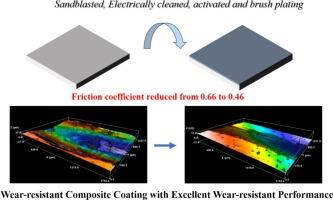通过刷镀制备 304 不锈钢上的 Ni-SiC 复合涂层及其摩擦学性能
IF 5.3
2区 材料科学
Q1 MATERIALS SCIENCE, COATINGS & FILMS
引用次数: 0
摘要
304 不锈钢的硬度较低,容易磨损,这增加了工件在实际使用过程中出现故障的概率。本研究利用电刷镀设备在 304 不锈钢上成功制备了 Ni-SiC 复合镀层,有效提高了材料的表面耐磨性。通过表征复合镀层的微观结构和性能,我们确定了刷镀 Ni-SiC 耐磨镀层的最佳工艺参数,并揭示了该保护层的磨损机理。将制备复合镀层的参数调整为电压 10 V、相对运动速率 8 m/min、镀液温度 50 °C、SiC 浓度 15 g/L,得到的耐磨镀层的显微硬度值为 457 HV0.1,摩擦系数为 0.46。据观察,在 SiC 溶液浓度低于 5 g/L 的 Ni-SiC 复合镀层中,疲劳磨损机制占主导地位,而在 SiC 溶液浓度超过 10 g/L 的 Ni-SiC 复合镀层中,氧化磨损和磨料磨损机制占主导地位。本文章由计算机程序翻译,如有差异,请以英文原文为准。

Preparation and tribological performance of Ni-SiC composite coating on 304 stainless steel through brush plating
The low hardness of 304 stainless steels makes them susceptible to wear, which increasing the probability of workpiece failure during actual use. In this study, a Ni-SiC composite coating was successfully prepared on 304 stainless steel using brush plating equipment, effectively enhancing the material's surface wear resistance. By characterizing the microstructure and properties of the composite plating layer, we determined the optimal process parameters for brushing Ni-SiC wear-resistant plating and revealed the wear mechanism of this protective layer. When the parameters for preparing the composite plating coating were adjusted to a voltage of 10 V, a relative motion rate of 8 m/min, a plating solution temperature of 50 °C and a SiC concentration of 15 g/L, the resulting wear-resistant plating coating exhibited an impressive microhardness value of 457 HV0.1 and a friction coefficient of 0.46. It was observed that the fatigue wear mechanism dominated in Ni-SiC composite coatings with a solution SiC concentration below 5 g/L, while oxidative and abrasive wear mechanisms were dominant in Ni-SiC composite coatings with solution SiC concentrations exceeding 10 g/L.
求助全文
通过发布文献求助,成功后即可免费获取论文全文。
去求助
来源期刊

Surface & Coatings Technology
工程技术-材料科学:膜
CiteScore
10.00
自引率
11.10%
发文量
921
审稿时长
19 days
期刊介绍:
Surface and Coatings Technology is an international archival journal publishing scientific papers on significant developments in surface and interface engineering to modify and improve the surface properties of materials for protection in demanding contact conditions or aggressive environments, or for enhanced functional performance. Contributions range from original scientific articles concerned with fundamental and applied aspects of research or direct applications of metallic, inorganic, organic and composite coatings, to invited reviews of current technology in specific areas. Papers submitted to this journal are expected to be in line with the following aspects in processes, and properties/performance:
A. Processes: Physical and chemical vapour deposition techniques, thermal and plasma spraying, surface modification by directed energy techniques such as ion, electron and laser beams, thermo-chemical treatment, wet chemical and electrochemical processes such as plating, sol-gel coating, anodization, plasma electrolytic oxidation, etc., but excluding painting.
B. Properties/performance: friction performance, wear resistance (e.g., abrasion, erosion, fretting, etc), corrosion and oxidation resistance, thermal protection, diffusion resistance, hydrophilicity/hydrophobicity, and properties relevant to smart materials behaviour and enhanced multifunctional performance for environmental, energy and medical applications, but excluding device aspects.
 求助内容:
求助内容: 应助结果提醒方式:
应助结果提醒方式:


